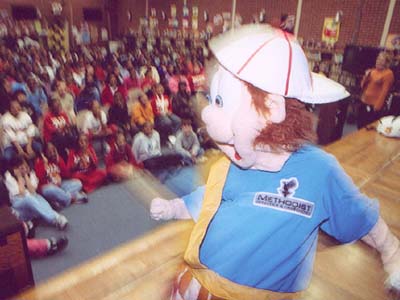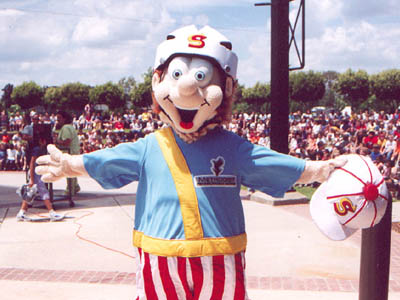JACKSON, Miss.—It’s a moment in her long career that she will never live down.
Lynn Porter was dressed as Sammy Soil and entertaining the crowd at a popular garden festival when her costume’s drawstring pants started to droop.
Porter couldn’t cry for help. “Sammy’s not supposed to talk,” said the education specialist for the Hinds County Soil and Water Conservation District. Nor could she zip into a nearby phone booth; the festival was in the middle of a field. And all her attempts to alert her escort were to no avail.
So Sammy’s pants soon plummeted down around his leaf-wrapped feet. “Thank goodness I had shorts on,” Porter said. “The young kids were shocked. I no longer had dirt legs, just white legs. I wanted to die.”
When you suit up to be a mascot, anything can happen – and dying of embarrassment is hardly the biggest danger. Sports team mascots, for instance, are frequent targets for abuse.
“I’ve been attacked several times,” said John Mills of Hattiesburg, a Capital One All-American team mascot who has worn the University of Southern Mississippi’s Seymour costume for the last three and a half years. “I was shot at with a potato gun at one school and hit by fraternity paddles. And I’ve actually been in a fistfight before.”
Quint Withers, the guy inside the Millsap’s Major mascot, once literally ran for his life while in costume, pursued by an irate 8-year-old with a metal baseball bat.
“I had stepped on his foot and he went back to his family’s camper and got the bat. He yelled: ‘Hey you,’ and went whap! I got a lump on my head and had to have a doctor look at it. I had a headache about four days.”
To add insult to injury, the crowd watching the drama laughed throughout thinking it was a staged skit. Such is life when you’re the inner being inside a cartoon-like costume. People think they can steamroll you like the Coyote and you’ll come back for more.
“A good friend of mine who is Big Al at the University of Alabama got beat up real bad by an opposing team. He ended up staying in the hospital for a day,” Withers said.
Even mild-mannered Sammy Soil has taken some tough licks from mischievous kids. “If you turn your back on some, you are going to get a kick in the rump,” Porter said.
A 2001 study by Johns Hopkins Medical Institutions indicates mascots might be better off switching their furry finery for a suit of armor. The 48 professionals mascots that were surveyed reported an average of 2.7 injuries for every 1,000 appearances. Of the 179 injuries reported, 22 required surgery.
Many of those injuries were self-inflicted, the result of mascots trying to one-up each another with attention-getting stunts. Mariner Moose, of pro baseball’s Seattle Mariners, once crashed into the centerfield wall while being towed on in-line skates. He suffered a dislocated knee and ankle, a fractured ankle and the humiliation of seeing his accident replayed on dozens of sports shows.
In the John Hopkins study, 44 percent of the mascots reported chronic lower back pain and 17 percent suffered knee injuries. But the worst threat by far (at 58 percent) was one Southern mascots know all too well – killer heat.
“Dehydration is a really huge problem,” Mills said. “We had one guy have a heat stroke, and we see a lot of overheating and vomiting. If you see a mascot running through a crowd toward the bathroom, you know what is about to happen.”
Pierre Deschesnes of Gautier, a Canadian-born mascot with 10 years experience, including stints as the Montreal Expos’ Youppi, said you can lose from 5 to 8 pounds during a game. “If it’s 90 degrees outside, you can easily add another 20 degrees in the costume.”
Deschesnes now travels the country freelancing as the Elmo-like character Jumping Jack and hosting occasional mascot seminars. His instruction includes the cardinal rules of mascot etiquette: Never take off your head in public. Never speak. Don’t force yourself on children. And watch out for overzealous fans.
When affection comes in the form of a frenzy-propelled 4-year-old, love can literally hurt. And since toddlers are in the head-butting vicinity of some very vulnerable anatomy, male mascots are advised to wear protective gear.
In addition to protecting themselves, mascots also are taught to safeguard their costumes. “I learned very early to always keep your tail to the wall,” said Matt Purvis, an acquisitions assistant for the Central Mississippi Regional Library System and the man inside Acorn, the system’s book-loving squirrel mascot. “Kids love to bounce around on Acorn’s large tail.”
Considering the hazards of the job, it’s certainly not a career for the timid. But those who who bring life to costumed characters say the role has its rewards.
“If you have never lived it, you can’t really know how fun it is,” Deschesnes said. “Giving a show in front of 55,000 people is extremely electrifying.”
And even small moments can leave a lasting impression. Mills said he will never forget the time a couple of distraught USM fans thrust their tiny, terminally-ill preemie into Seymour’s hands and took a photograph. “It’s all about doing everything you can for the kids,” he said.


